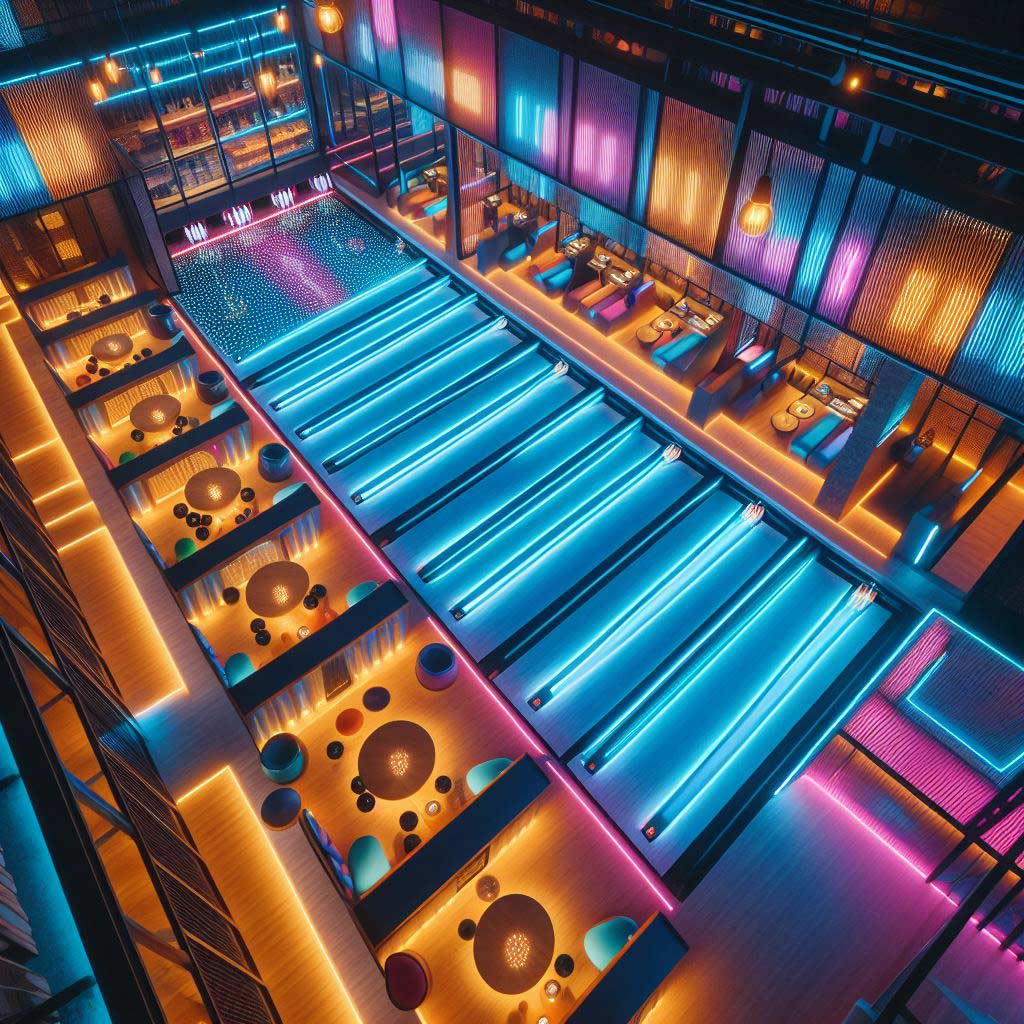Bowling is a popular sport and recreational activity enjoyed by over 70 million people in the United States alone. The venue of choice for bowling fans is the trusty bowling alley. But if you’ve ever wondered “how many lanes are in a bowling alley?” the answer may vary more than you might think.
While there are typical standards and conventions when it comes to bowling lane numbers, alleys can range dramatically in size. The number of lanes can be influenced by factors like the overall dimensions of the facility, whether the alley is catering to league players or families just looking to have fun and other logistical considerations.
In this article, we’ll break down the typical lane number conventions and regulations, while also exploring some lane variations you might encounter at different bowling alleys around the country. Let’s roll!
Typical Bowling Alley Lane Number Standards
Most regulation bowling alleys have 20-40 lanes as their sweet spot. This provides enough lanes to accommodate casual bowlers and leagues, without taking up an excessive amount of space.
According to the United States Bowling Congress (USBC) Equipment Specifications and Certifications manual, regulation bowling lanes must be 60 feet from the foul line to the headpin. They also must be at least 42 inches wide.
Having a long and narrow shape, alley architects and designers aim to fit as many regulation-length lanes as possible given the dimensions of the building space.
With 40 lanes often being the high end before very large specialty alleys, a typical bowling alley may have room for 30 lanes in a compact site or 20 lanes in a smaller footprint location.
This gives casual bowlers plenty of lane availability options during normal operation. It also allows for multiple leagues to hold games and practice during peak league hours. Most league tournaments require groups of 4-8 connected lanes for competition.
Factors That Influence Bowling Alley Lane Numbers
While 20-40 lanes is the norm, the exact number of lanes in a particular bowling center will depend on several factors:
Bowling Alley Size
Larger facilities with more land or square footage to work with can comfortably accommodate greater lanes numbers, while still providing ancillary spaces like an arcade, lounge, concessions, etc.
For example, luxury “bowling stadiums” might have 50 lanes or more, given their sprawling scale.
On the other hand, an alley in a downtown urban area or mall will likely top out at around 30 lanes or fewer based on space constraints.
Bowling Alley Type
The target customer and bowler type that a bowling alley caters to will also impact lane decisions.
Big centers hoping to host tournaments and leagues require abundant lanes to run multiple events simultaneously. Top tournament spots boast 60+ regulation lanes.
Meanwhile, a small town alley that just services weekend casual bowlers may need far fewer lanes, like 10-15 to meet demand.
The geographic region also plays a role, as hot spots like Texas and Florida can support more lanes than sparse populations in the Mountain West.
Building Layout Limitations
In some cases, physical building limitations dictate the lane count more than anything else. Support columns, utility configurations, and fire safety plans can constrain lane options if not ideally organized.
Pre-existing buildings retrofitted as bowling alleys are particularly subject to quirks and creative lane arrangements around structural features.
However, skillful alley designers can usually optimize lane layouts for 20 or more regulation lanes in most retail spaces.
Variations in Bowling Alley Lane Numbers
While 20-40 lanes may be the standard, it’s not unusual to find lanes numbers above or below that range if the situation calls for it.
Small Bowling Alleys
Some small towns or amusement centers may get by with a “mini” bowling alley with only 8-12 lanes total.
This modest lane count keeps costs down but still gives a traditional bowling option when high demand isn’t expected.
Small bowling zones are sometimes even incorporated into restaurants, bars, or arcades as an activity for patrons.
Large Bowling Centers
On the other end of the spectrum, you may encounter sprawling bowling centers with anywhere from 50 to 100 lanes in their arsenal.
These mega alleys often provide an upscale, luxury bowling experience with modern amenities, full food and drink service, and advanced scoring systems.
Their expansive size allows them to host large tournaments and multiple leagues simultaneously with lanes to spare.
Boutique Bowling Alleys
In a unique twist, some newer alley concepts opt for just 2-6 lanes in a cozy, boutique environment.
Often situated in urban areas, these pint-sized bowling havens attract customers with retro-chic decor, unique music, and a lively lounge scene.
With limited lanes, they aren’t equipped for leagues or big crowds. But the intimate vibe offers a relaxed night out option for young professionals, dates, and small gatherings.
Other Lane Considerations
Beyond just the sport lanes themselves, there are a few other lane-related factors that bowling alley designers consider:
Approach Area
The approach area is the space for bowlers to stand before rolling a ball. The regulation specifies 15 feet of approach space so bowlers can build momentum. This must be factored around lanes.
Gutters
Alley lanes have gutters on either side to catch errant balls. Conventional gutters are 7-9 inches wide. Some high-tech lanes feature light-up digital gutters.
Pin Decks
Behind the bowling pins are pin decks that hold and reset the pins after each roll. Modern mechanical pin decks require room behind each lane.
Pin setting Machines
Closely tied to the pin decks are the pinsetting machines. First introduced in the 1950s, these ingenious devices clear fallen pins and reset them after each roll. Lanes require adequate clearance for their pinsetters.
Lane Maintenance
To keep lanes in top condition, regular oiling and buffing maintenance is needed. Multi-lane facilities usually have specialized lane maintenance equipment for this purpose.
Bowling Alley Lanes – The Bottom Line
So in summary – while most regulation bowling alleys have 20-40 lanes for optimal bowling capacity, the exact lane number can vary based on the facility size, location, target customer, and other factors.
Some novelty bowling concepts creatively maximize small spaces with just 8-12 lanes, or even go “boutique” with only 2-6 lanes.
On the other end of the spectrum, mega bowling stadiums boast upwards of 50-100 lanes to host tournaments and leagues.
But whether you’re rolling strikes at a cozy 8-lane alley or spacious 60-lane center, the fun of bowling is accessible at facilities of all sizes.
The regulations ensure each lane provides bowlers with the same balanced playing field. Variables like lane surface friction can alter ball motion, but the foundational 60-foot lane dimensions remain consistent everywhere.
So next time you visit the lanes, take a minute to appreciate the alley’s engineering and design that brings together the right blend of lanes, seating, concessions, and amenities.
With over 3,700 registered bowling alleys across the United States, there are plenty of venues to choose from. No matter what your taste, you can find the ideal setting to bowl your next perfect 300 game!
Frequently Asked Questions
How many lanes should be in a bowling alley?
The ideal number of lanes for most bowling alleys is 20-40. This provides enough capacity for casual bowlers and leagues without being overly massive. Larger centers can accommodate 50+ lanes.
How many lanes does the biggest bowling alley have?
The largest bowling alley in the world is the Inazawa Grand Bowl in Japan with 116 lanes! In the United States, the largest is the Grand Station Entertainment in Missouri with 104 lanes.
How many lines does a bowling alley have?
A standard bowling alley lane is 60 feet long from the foul line to the headpin. Each lane also has two gutters, one on either side. So one bowling lane contains 60 feet of lane plus two 7-10 inch gutters.
How many people can fit in a bowling lane?
Typically 6 people can comfortably fit in a standard 5-person bowling lane. If lanes have more than 5 spots in a league, some groups may accommodate 7-8 people by squeezing together or using adjacent lanes.
Is owning a bowling alley profitable?
Owning a bowling alley can be profitable if well-managed. Keys to profitability include an appealing location, investing in upgrades, offering food/drinks, hosting events/leagues, and focusing on customer service. High costs and maintenance are challenges.
How long does it take to bowl 1 game?
One standard game of bowling takes 10 frames or about 15-20 minutes for most bowlers. Professional bowlers average about 12-15 minutes per game. Games move faster with fewer people per lane.
Where is the largest bowling alley in the USA?
The largest bowling alley in the United States is the Grand Station Entertainment in St. Peters, Missouri with 104 lanes. It covers over 46,000 square feet in total.
What bowling alley in the United States has the most lanes?
The bowling alley with the most lanes in the United States is Grand Station Entertainment in St. Peters, Missouri. With 104 total bowling lanes, it is the biggest in the country.
Why are bowling lanes so strong?
Bowling lanes need to withstand the force of 15-16 pound bowling balls rolling at high speeds. They are made from hard maple wood for strength. Lanes are engineered with cross-supports and reinforced underneath for durability.





